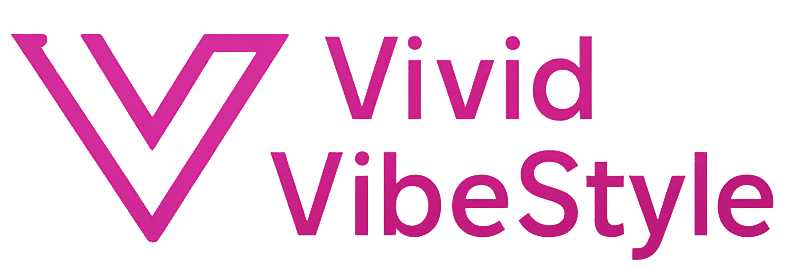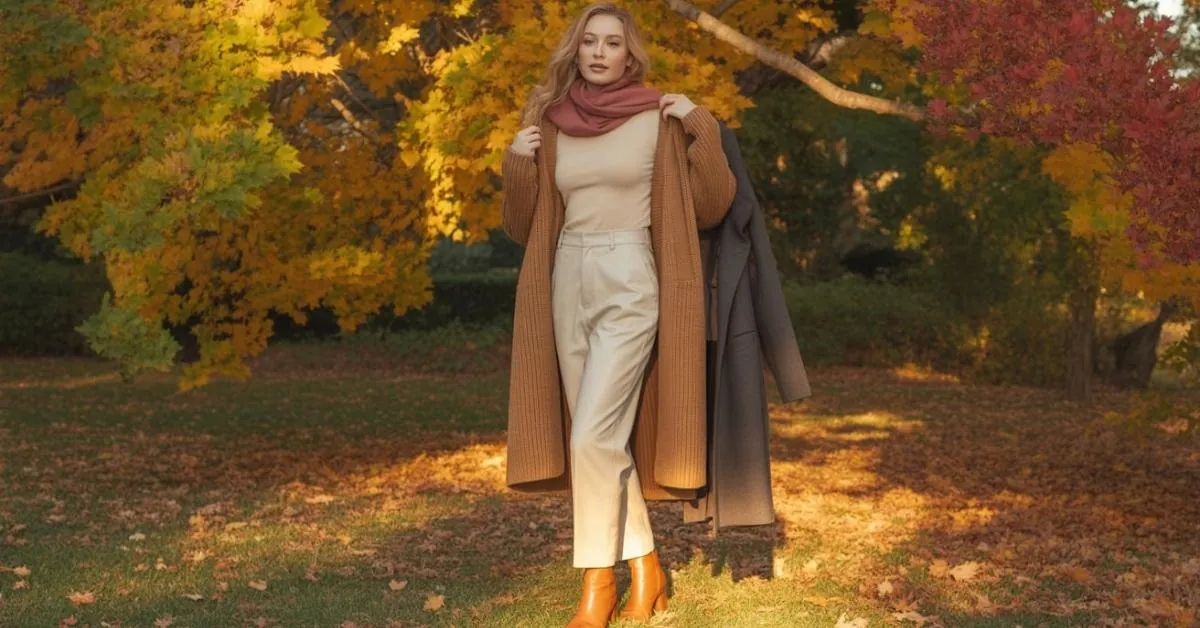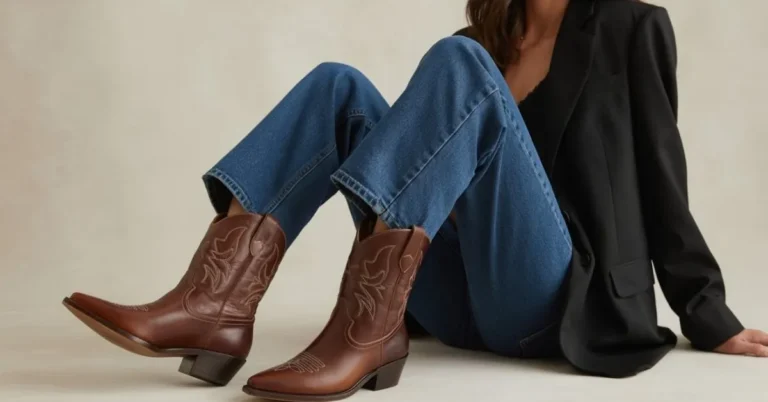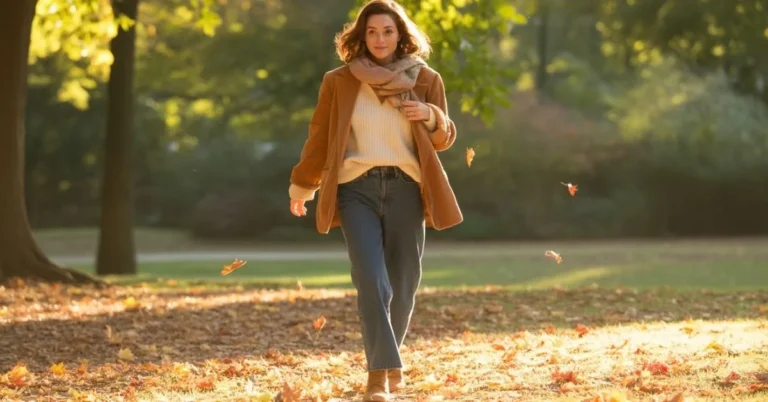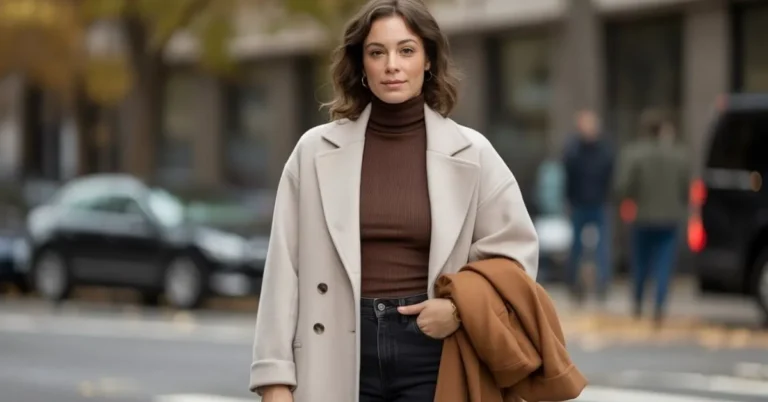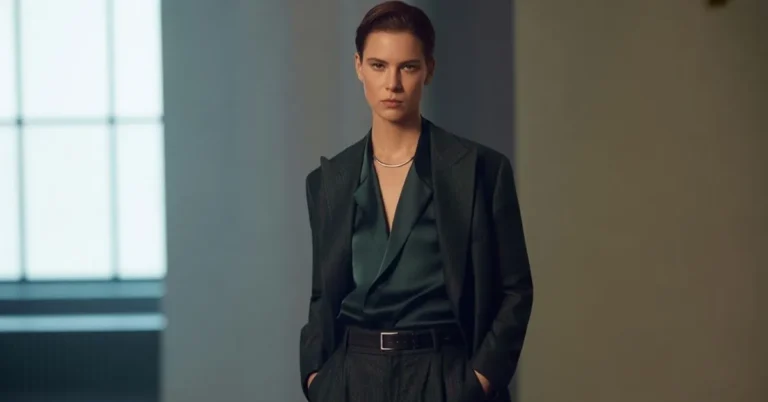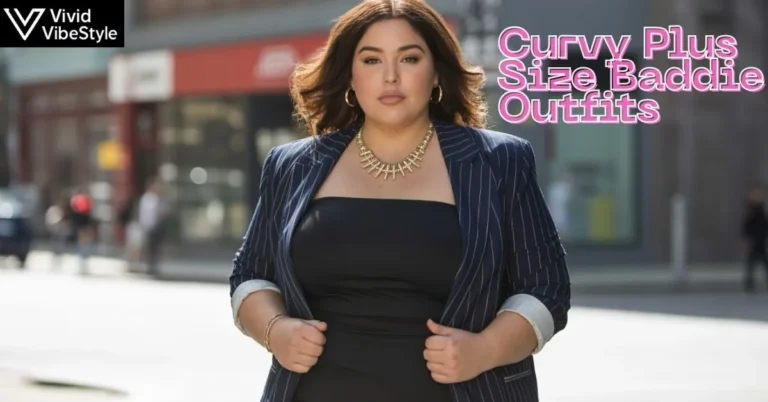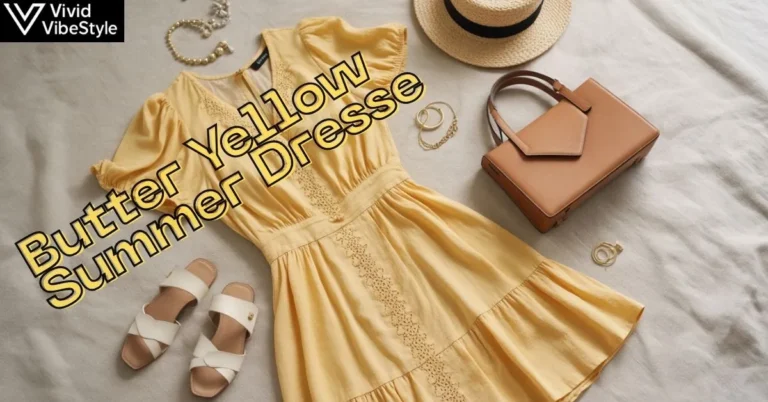The Complete Guide to Mastering Layered Fall Outfit Ideas in 2025
Fall weather brings the eternal struggle of unpredictable temperatures crisp mornings that warm into mild afternoons, then drop again by evening. You’re not alone if you’ve found yourself carrying a jacket, questioning whether you need that extra sweater, or feeling overdressed by noon. The constant temperature fluctuations make getting dressed a daily guessing game that leaves many people either shivering or sweating through their commute.
This frustrating cycle of outfit regret happens because most people approach layered fall outfit ideas as an afterthought rather than a strategic wardrobe solution. Without a clear system, you end up with bulky, unflattering combinations that look more accidental than intentional.
The solution lies in mastering the art of fall layering outfits, a skill that transforms unpredictable autumn weather from a styling challenge into an opportunity for creative expression.
When you understand the foundational principles of layered fall outfit coordination, you’ll create sophisticated looks that adapt effortlessly throughout the day while keeping you comfortable and stylish.
What Makes a Layered Fall Outfit Actually Work in 2025?
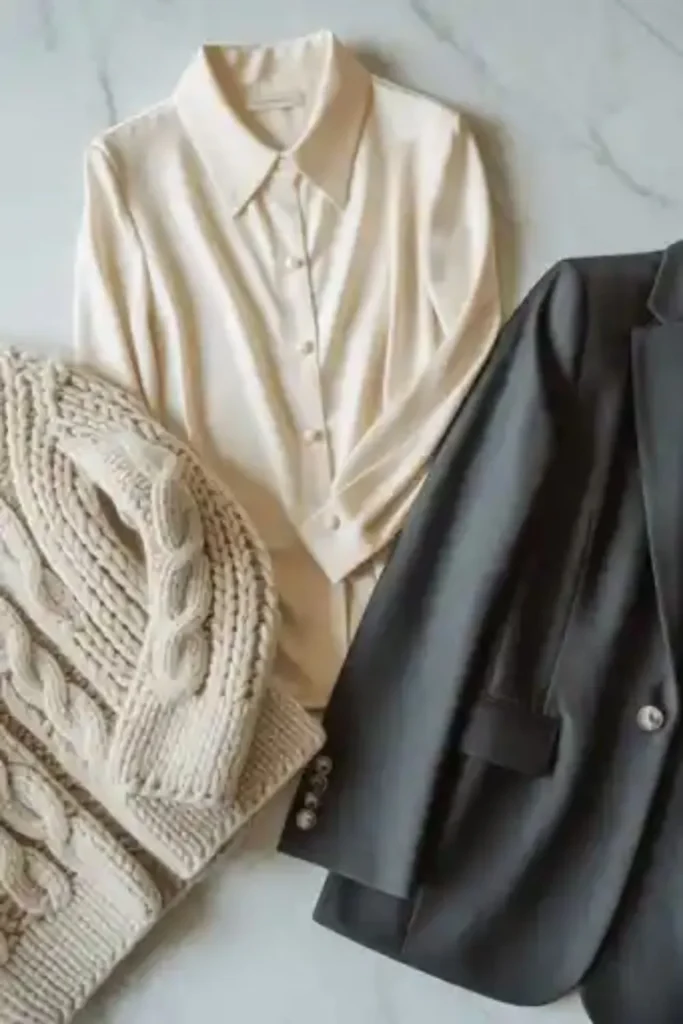
A successful layered fall outfit functions like a well-orchestrated symphony where each piece serves a specific purpose while contributing to the overall harmony. The foundation starts with understanding fabric weights, proportions, and how different textures interact with each other.
This season’s approach emphasizes “texture piled on top of even more texture, adding depth and interest to any layered outfit,” according to fashion editors. Modern fall layering outfits prioritize visual interest through contrasting materials rather than simply adding more pieces for warmth.
The most effective layered outfits for fall follow the “rule of three textures” combining smooth, textured, and structured fabrics within a single look. For example, pair a silk blouse (smooth) with a chunky knit cardigan (textured) under a tailored wool coat (structured). This creates dimensional interest while maintaining sophistication.
Base layer outfit combinations should start with fitted pieces that won’t create bulk when additional layers are added. Think lightweight merino wool tees, silk camisoles, or cotton-modal blends that move with your body. These foundational pieces allow you to build upward without sacrificing comfort or silhouette.
How Do You Build the Perfect Fall Outfit Layering Foundation?
The secret to mastering fall outfit layering lies in understanding the “layering hierarchy” a systematic approach that ensures each piece complements rather than competes with the others. Start with your base layer as the anchor that determines the color palette and overall vibe of your look.
Autumn layered outfits work best when you establish a cohesive color story from the start. Choose a neutral base color (cream, gray, camel, or black) and build with one to two accent colors maximum. This prevents your outfit from looking chaotic while allowing for creative expression through different textures and silhouettes.
Your middle layer typically a cardigan outfit fall style, sweater, or light jacket should contrast your base layer in either texture or weight. If you start with a smooth silk blouse, add a chunky knit. If your base is a textured henley, layer with a sleek blazer or structured vest.
Fall sweater layering requires special attention to proportions. When combining multiple knits, vary the weights significantly. Pair a lightweight cashmere turtleneck with an oversized cable-knit cardigan, or layer a fitted merino pullover under a chunky wool vest. This prevents the “marshmallow effect” that makes layered looks appear bulky rather than intentional.
Read More About : 80+ Vintage Y2K Outfit Ideas That Scream Early 2000s Nostalgia
Which Fall Layering Pieces Should You Invest in for 2025?
For fall 2025, “Long coats, from sweeping wool overcoats to sleek tailored trenches, are everywhere” and serve as the ultimate layered fall outfit anchors. These statement outerwear pieces allow you to build sophisticated looks underneath while ensuring you stay warm during temperature drops.
Fall cardigan outfits have evolved beyond basic button-ups. The “short-waist cardigan is back in rotation” six years after Katie Holmes made cropped cardigans iconic. These waist-defining styles work perfectly over fitted tees and under blazers, creating the illusion of a two-piece set while maintaining layering functionality.
Suede jackets add “a bit of edge that enhances a minimalist look,” while “funnel-neck jackets, especially those that are a bit sporty, are poised to be fall’s number one jacket trend.” These pieces bridge the gap between casual and refined, making them perfect for transitional fall outfits.
Layering essentials for fall should include versatile pieces that work across multiple outfit formulas. Invest in a lightweight wool turtleneck, a structured blazer, a mid-weight cardigan, a silk button-down, and a statement coat. These five pieces can be mixed and matched to create dozens of layered fall outfit combinations.
Fall fashion layering accessories deserve equal attention. “Swooping scarfs on coats still reign supreme,” offering both practical warmth and visual interest. Choose scarves in colors that complement your coat rather than match exactly this creates depth and prevents your look from appearing too coordinated.
What Are the Best Layered Fall Outfit Ideas for Different Body Types?
Petite fall layering requires strategic proportions to avoid overwhelming your frame. Stick to fitted base layers with one structured mid-layer, avoiding bulky or oversized pieces that can make you appear smaller. Choose cropped cardigans, fitted blazers, and hip-length coats that don’t cut your silhouette in unflattering places.
For petite frames, fall outfit layering works best when you maintain vertical lines. Layer a fitted turtleneck under a long, open cardigan, or wear a structured blazer over a silk blouse with tailored trousers. The key is ensuring each layer serves a purpose rather than adding bulk.
Plus-size layered outfits should focus on creating structure and definition through strategic layering. Use fitted base layers as your foundation, then add flowing or structured pieces that skim your body rather than cling. A well-fitted tee under an open cardigan with a statement necklace creates vertical interest while maintaining comfort.
Tall frame fall layering allows for more experimentation with proportions and layers. You can successfully wear oversized pieces, multiple patterns, and chunky textures that might overwhelm smaller frames. Try layering a turtleneck under a slip dress with an oversized blazer for an effortlessly chic layered fall outfit.
Apple shape layering benefits from creating definition at the narrowest part of your waist. Layer a fitted top under an open cardigan or blazer that hits at your natural waistline. Avoid layers that cut across your midsection at unflattering angles, instead focusing on pieces that flow over your torso while highlighting your assets.
How Do You Master Professional Fall Layering for the Office?
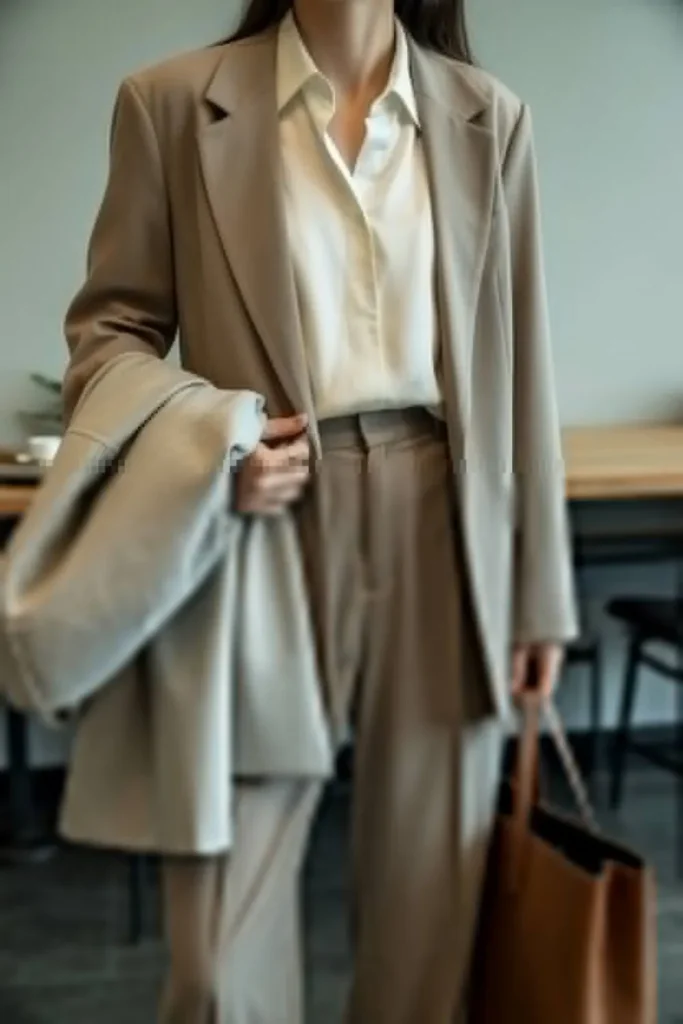
Workwear fall outfits require sophistication while maintaining the flexibility to adjust for changing office temperatures. The foundation should be a polished base layer silk blouse, fitted turtleneck, or structured knit that looks complete on its own if you need to remove outer layers.
Business casual layered looks work best when you combine classic pieces with subtle trend elements. Layer a cream silk blouse under a structured blazer with tailored trousers, then add a lightweight wool scarf for texture and warmth. This formula translates across industries while allowing for personal style expression.
Office appropriate fall layering means avoiding overly casual pieces like hoodies, athletic wear, or heavily distressed items. Instead, focus on refined materials like wool, cashmere, silk, and quality cotton blends. Your layers should enhance rather than hide your professional appearance.
The key to successful professional layered outfits lies in maintaining clean lines and intentional styling. Each layer should serve a purpose whether for warmth, style, or both. Avoid mixing too many patterns or textures in a single outfit, instead focusing on tonal variations and complementary materials.
Meeting-ready fall looks should be easily adjustable throughout the day. Layer a fitted cardigan over a blouse so you can remove it during presentations or add it back for air-conditioned conference rooms. Choose pieces that won’t wrinkle easily and maintain their shape throughout long workdays.
Read More About : Preppy Chic Outfits: Master the Art of Sophisticated Collegiate Style
What Are the Hottest Fall 2025 Layering Trends to Try Now?
Purple is “revving up for a headlining role this fall think velvet tuxes and brocaded evening coats worthy of a modern Medici.” Incorporate this trending color into your layered fall outfits through statement pieces like a plum cardigan or violet silk blouse.
Textural mixing remains the dominant trend in fall fashion layering for 2025. The emphasis is on “texture piled on top of even more texture,” encouraging fashion enthusiasts to experiment with unexpected combinations like velvet blazers over silk shirts or corduroy jackets with cashmere turtlenecks.
Knit tees and short-sleeved cardigans are perfect for “early fall wardrobe” styling, helping to “keep your favorite skirts and dresses in rotation a little longer.” These lighter-weight layers bridge the gap between summer and winter pieces, making them essential for transitional fall outfits.
Oversized blazer layering continues to dominate street style and runway looks. Fashion editors recommend “oversized bombers, stylish windbreakers, a cropped tweed number with faux leather pockets, and a quilted chambray topper” as key pieces for creating interesting layered fall outfit combinations.
Color blocking through layering offers a modern approach to autumn outfit coordination. Instead of matching every piece, try layering complementary colors forest green with cream, burgundy with camel, or navy with gray. This creates visual interest while maintaining sophistication.
How Can You Create Casual Layered Fall Outfits That Still Look Polished?
Weekend layering looks should balance comfort with style, focusing on pieces that feel as good as they look. Start with soft, breathable base layers like cotton-modal blends or lightweight merino wool, then add structured pieces for visual interest.
The key to elevated casual fall layering lies in choosing elevated versions of relaxed pieces. Instead of a basic hoodie, opt for a cashmere pullover. Rather than generic leggings, choose ponte pants or good-quality denim. These upgrades instantly improve the sophistication of your layered fall outfit.
Athleisure fall layering works when you balance sporty elements with refined pieces. Layer a fitted athletic top under an oversized cardigan with tailored joggers and clean white sneakers. The contrast between athletic and refined elements creates an effortlessly chic look.
Errand-running outfits need to be practical while maintaining style. Layer a fitted tee under an open cardigan with comfortable jeans and ankle boots. Add a crossbody bag and delicate jewelry to elevate the look. This formula works for everything from grocery shopping to school pickup.
Date night casual layering allows for more creativity and texture play. Try layering a silk camisole under a sheer button-down with dark jeans and heeled boots. Add a leather jacket for edge, or substitute with a soft cardigan for a more romantic vibe.
What Fall Layering Mistakes Are You Making (And How to Fix Them)?
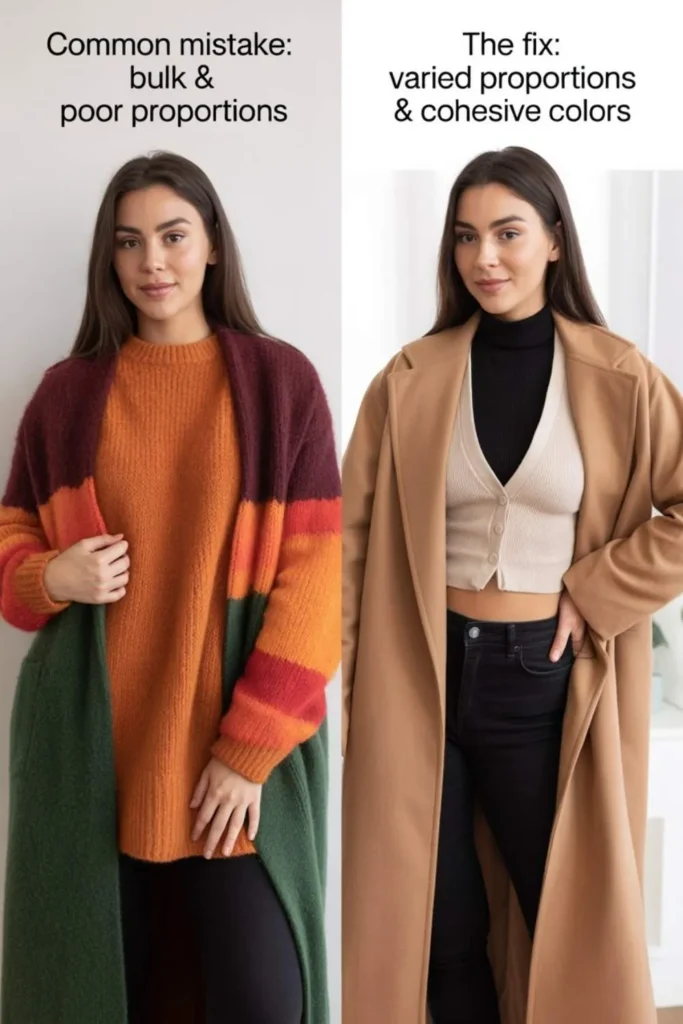
The biggest mistake in fall outfit layering is treating it as simply adding more clothes rather than creating a cohesive look. Each layer should contribute to the overall aesthetic while serving a functional purpose. Random combinations rarely create the polished appearance you’re seeking.
Proportion mistakes happen when all your layers are the same length or fit. If you’re wearing a fitted top, add an oversized cardigan. If your cardigan is cropped, choose a longer base layer. Varying lengths and fits creates visual interest and prevents the dreaded “sausage effect.”
Color chaos occurs when you mix too many competing colors without a unifying element. Stick to a three-color maximum rule: one neutral, one main color, and one accent. This keeps your layered fall outfit looking intentional rather than thrown together.
Fabric weight confusion leads to uncomfortable and unflattering combinations. Don’t layer heavy materials over delicate ones, a thick wool sweater over a silk blouse will create bulk and may damage the delicate fabric. Instead, layer from lightest to heaviest, with the heaviest piece as your outermost layer.
Overthinking accessories can ruin an otherwise perfect layered fall outfit. When you’re wearing multiple clothing layers, keep accessories minimal and strategic. One statement piece earrings, necklace, or scarf is usually sufficient. Multiple statement accessories compete with your carefully constructed layers.
Read More About : Coffee Brown Pants Outfit: The Ultimate 2025 Styling Guide for Every Occasion
How Do You Transition Your Summer Pieces into Fall Layered Outfits?
Transitional dressing allows you to maximize your wardrobe investment by extending the life of summer pieces into cooler months. The key is strategic layering that transforms warm-weather items into autumn-appropriate looks.
Fashion experts recommend focusing on “ways to dress during the most annoying in-between summer and fall weather” by using lightweight layers that can be easily added or removed as temperatures fluctuate throughout the day.
Your favorite summer dress becomes fall-ready when layered under a cardigan or blazer with tights and ankle boots. Fashion insiders suggest “wearing this jacket with a shorter dress and tights as the weather gets a bit chillier,” proving that strategic layering extends seasonal wearability.
Tank top layering works beautifully for fall when you add structured pieces. Layer a fitted tank under an open button-down with the sleeves rolled up, then add a lightweight scarf for texture. This combination works for everything from brunch to casual Fridays.
Short sleeve to long sleeve transitions happen naturally with layering. Wear your favorite summer blouse over a lightweight turtleneck, or layer a short-sleeve cardigan over a long-sleeve fitted tee. These combinations create new looks while keeping you comfortable during temperature changes.
What Fall Layering Accessories Complete Your Look?
Scarf styling remains crucial for layered fall outfits in 2025. Designers continue to emphasize “swooping scarfs on coats,” making them essential accessories for adding color, texture, and visual interest to your autumn looks.
The art of scarf layering involves choosing the right weight and size for your outfit proportions. Lightweight silk scarves work beautifully with tailored blazers, while chunky knit scarves complement casual cardigans and denim jackets. Match the formality level of your scarf to the overall vibe of your layered fall outfit.
Statement jewelry should complement rather than compete with your layers. When wearing multiple clothing pieces, choose jewelry that fills in the gaps rather than adding bulk. Long necklaces work beautifully with V-neck layering, while statement earrings shine when your neckline is covered.
Bag selection for layered looks requires considering both proportion and practicality. Designers are showing “squishy bags” as a major trend, offering a relaxed contrast to structured fall layering outfits. Choose bags that complement your layer proportions without overwhelming your silhouette.
Boot styling anchors your layered fall outfit and should be chosen based on your overall aesthetic. Ankle boots work with cropped pants and midi skirts, while knee-high boots pair beautifully with dresses and tucked-in tops. Consider the shaft height in relation to your layer hemlines for the most flattering proportions.
Read More About : Matcha Toned Outfit Ideas: Master 2025’s Most Calming Color Trend
Frequently Asked Questions
How many layers should you wear for fall weather?
The ideal number of layers for fall weather is typically 2-3 functional pieces plus outerwear. Start with a fitted base layer, add one mid-layer for warmth or style (cardigan, blazer, or light sweater), and finish with outerwear when needed. More than four layers can appear bulky and restrict movement.
What’s the best base layer for fall layering outfits?
The best base layers for layered fall outfits are fitted, breathable pieces made from natural or high-quality synthetic fibers. Lightweight merino wool, cotton-modal blends, and silk work excellently because they regulate temperature, wick moisture, and create smooth foundation for additional layers without adding bulk.
How do you layer without looking bulky in fall outfits?
Avoid bulk in fall layering outfits by varying fit types and fabric weights. Pair fitted pieces with looser ones, choose lightweight materials for base layers, and ensure your outermost layer is structured enough to create a flattering silhouette. Focus on proportions and avoid layering multiple thick fabrics together.
Conclusion
Creating stunning layered fall outfits transforms from overwhelming challenge to creative opportunity when you understand the fundamental principles of proportion, texture, and strategic styling.
The most successful autumn looks balance functionality with fashion, ensuring you stay comfortable while looking effortlessly put-together throughout unpredictable weather changes.
Remember that the best fall layering outfits tell a cohesive style story where each piece serves a purpose. Whether you’re building professional workwear combinations or casual weekend looks, focus on quality pieces that work harmoniously together rather than simply adding more clothing.
With these expert techniques and current trend insights, you’ll create layered fall outfits that not only keep you perfectly temperatured but also earn compliments wherever you go. Start with your wardrobe essentials and experiment with one new layering technique each week to build confidence and develop your personal autumn style signature.
